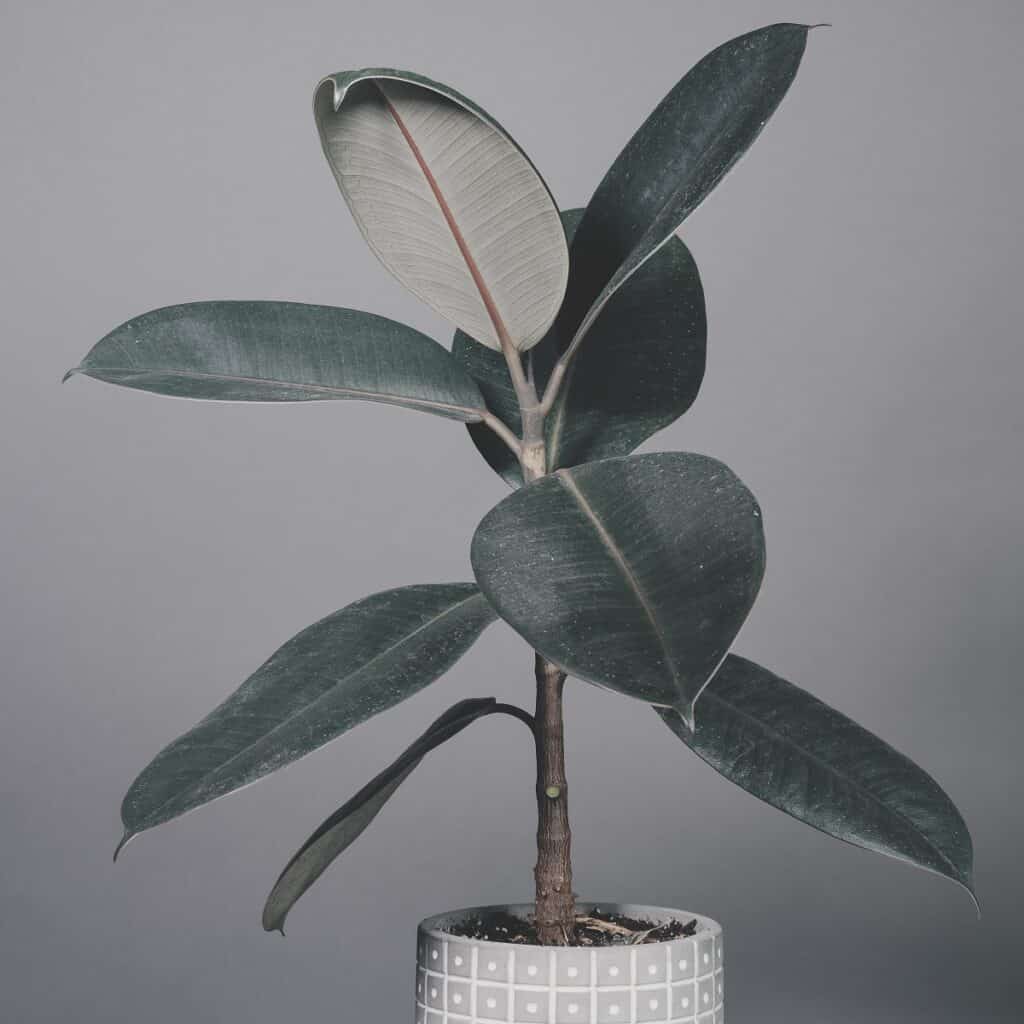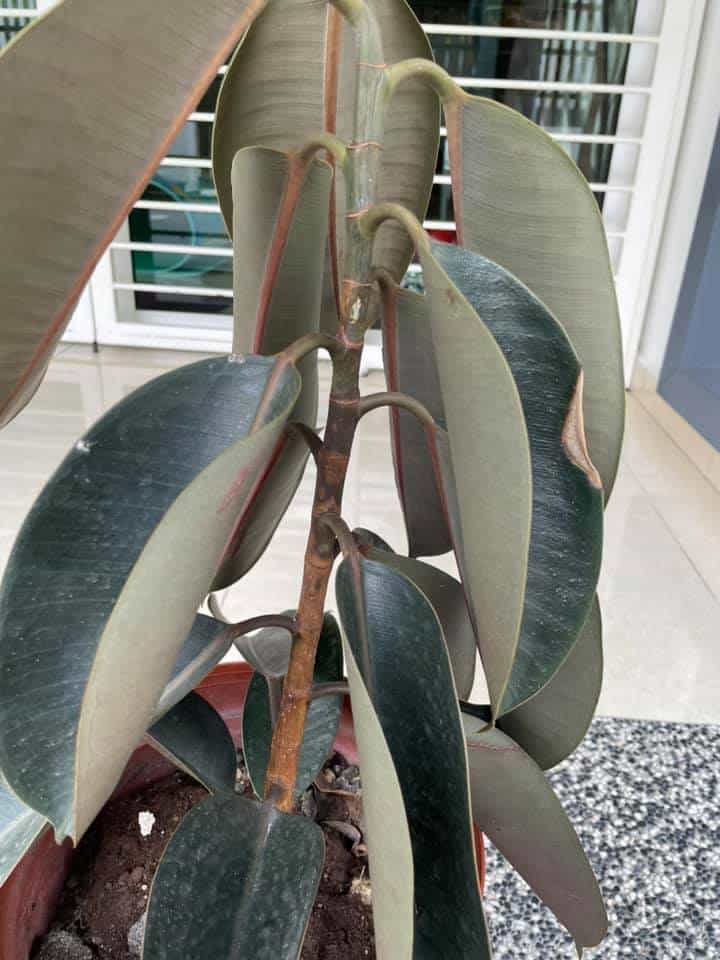When it comes to houseplants, the rubber plant is a popular choice for those looking for low-maintenance greenery. But even the hardiest of plants can suffer from the effects of underwatering. Have you recently noticed that your rubber plant is looking a little droopy? Before you throw in the towel and toss it, read on to learn more about the signs of an underwatered rubber plant and the solutions to help save it.

Contents
Signs Of An Underwatered Rubber Plant
Underwatering your rubber plant is a common mistake and one that can be easily corrected with some simple steps. But, before you can correct the problem, you need to be able to recognize the signs of underwatering.
The most obvious sign of underwatering is drooping or wilting leaves. When a rubber plant is underwatered, its leaves will start to droop and become limp. This is a sign that the plant isn’t getting enough water and needs to be watered more often. Wilting leaves may also be accompanied by brown edges on the leaves.
Another sign of underwatering is dry or cracked soil. When a rubber plant isn’t getting enough water, the soil can become dry and cracked. This is a sign that your rubber plant isn’t getting enough water and needs to be watered more frequently.
The last sign of underwatering is stunted or slow growth. When a rubber plant isn’t getting enough water, it can’t get the nutrients it needs to grow. This can lead to slow or stunted growth, which is a sign that your rubber plant needs more water.
These are the most common signs of underwatering in a rubber plant. If you notice any of these signs, it’s important to act quickly and give your rubber plant the water it needs.

Causes Of Underwatering
Underwatering is a common problem when it comes to rubber plant care. It can be caused by a variety of factors, all of which can lead to an unhealthy and unhappy rubber plant.
One of the most common causes of underwatering is simply not giving the rubber plant enough water. This could be due to not understanding the rubber plant’s needs, forgetting to water the plant, or simply not providing enough water in each watering. If the soil is allowed to dry out too much, it can cause the plant to become stressed and suffer from dehydration.
Another cause of underwatering is using containers that are too small. Using containers that are too small can also cause the soil to dry out quickly. When the soil doesn’t have enough room to hold moisture, it can lead to rapid water loss. Additionally, small containers can become very hot, which can speed up evaporation and cause the soil to dry out faster. To prevent underwatering, it is important to choose containers that are the appropriate size for the plant you are growing.
Solutions To Underwatering
1. Water Properly
The first and most important step to solving the issue of underwatering is to make sure your rubber plant is getting the proper amount of water. When watering your rubber plant, make sure the soil is completely saturated. Make sure not to overwater your rubber plant, as this can lead to root rot. If your soil is dry, water your plant thoroughly and wait until the soil is dry before watering again.
2. Repotting
If your rubber plant is severely underwatered and in a small pot, you may need to repot it. This will give your rubber plant a fresh start with more soil and nutrients. When repotting your rubber plant, be sure to use a pot with good drainage holes and soil that drains well.
3. Check the Roots
Sometimes the root system of a rubber plant can become damaged due to underwatering. If you notice any dead roots, trim them away and repot your rubber plant in fresh soil. This will help your rubber plant to start absorbing water and nutrients again.
4. Add Mulch
Adding a layer of mulch to the surface of the soil can help to retain moisture and help your rubber plant recover from underwatering. Make sure to check the mulch regularly, as it can become compacted and prevent the soil from draining properly.
Tips For Avoiding Underwatered Rubber Plant

Underwatering is a common problem for rubber plants, and it’s important to know how to avoid it. Here are some tips to help you keep your rubber plant healthy and well-watered:
First, know the signs of underwatering. Look for wilting leaves and a lack of growth. Also, check the soil for dryness; if it’s too dry, it’s a sign that the plant is not getting enough water.
Second, make sure to water your plant regularly. A good rule of thumb is to water your rubber plant once a week, but adjust the frequency according to your climate and the amount of sunlight the plant is receiving.
Third, make sure to use the right amount of water. Too much or too little can both cause problems. A good way to determine the right amount is to check the soil after you’ve watered it. If it’s still damp, then you’re good.
Finally, use a pot with good drainage. This will help ensure that the soil doesn’t become waterlogged, which can lead to root rot. Additionally, add some compost or other organic matter to the soil to help it retain moisture.
By following these tips, you can help ensure that your rubber plant stays healthy and properly watered.
Related Post:
17 Amazing Rubber Plant Benefits
How To Revive An Underwatered Rubber Plant

If you’ve found yourself with an underwatered rubber plant, don’t despair! With a few simple steps, you can revive your plant and get it back to its healthy, happy state.
The first step to reviving an underwatered rubber plant is to identify the symptoms. An underwatered rubber plant will have limp leaves that are starting to curl and turn yellow. You may also find that the soil is dry and the leaves are starting to drop off.
The next step is to water your rubber plant. Be sure to give it a good soak, making sure you water the soil and not just the surface. Use room temperature water and avoid using hard water, which can contain too many minerals and can damage the plant. Also, make sure to let the soil dry out slightly before watering again.
Once your rubber plant has been watered, it is important to give it enough light. Rubber plants need bright, indirect sunlight and should be placed near a window, but not directly in it.
Finally, you should give your rubber plant some fertilizer. A balanced fertilizer with an equal amount of nitrogen, phosphorus, and potassium will help your rubber plant revive. Make sure to follow the instructions on the package when fertilizing your rubber plant.
With these steps, you should be able to revive your underwatered rubber plant and get it back to its healthy, happy state.
Related Post:
Leggy Rubber Plant (Causes And Solutions)
Frequently Asked Questions

What does an underwatered rubber plant look like?
An underwatered rubber plant will usually appear wilted, with its leaves drooping down. The leaves may also appear dry and brittle, and the plant may have brown spots indicating dehydration. The leaves may turn yellow and eventually drop off if not watered properly.
The root system of an underwatered rubber plant may also become weak, leading to poor growth. To prevent this from happening, it is important to water the plant regularly and deeply. Check the soil for dryness and water when it feels dry to the touch. Additionally, it is important to ensure that the plant is not sitting in water as this can cause root rot. Make sure the plant is in a pot with drainage holes so that any excess water can escape.
How often should a rubber plant be watered?
When it comes to watering a rubber plant, the key is to simulate its natural environment. In the wild, rubber plants are found in humid rainforests, so they require regular watering to stay healthy. However, overwatering can be just as harmful as underwatering, so it’s important to get the balance right.
In general, a rubber plant should be watered when the top inch or two of the soil is dry. During the summer months, they may need to be watered more frequently—a good rule of thumb is to water them every 10 days or so. During winter, they may need to be watered less often, as the soil will take longer to dry out.
If you are unsure whether your rubber plant needs watering, you can check the soil with your finger. If it feels dry, it’s time to water. Alternatively, you can pick up a moisture meter from your local gardening store—this will help you to keep track of the soil moisture without having to actually touch the soil.
Finally, it’s important to remember that all plants have different needs, depending on the environment they’re in, so it’s a good idea to check the specific needs of your particular plant. With the right care, your rubber plant should thrive and be a beautiful addition to your home.
- Reliable and accurate
- Easy to read
- Less hurts to the roots
*As an Amazon Associate I earn from qualifying purchases.
How wet should the soil be for a rubber plant?
The soil for a rubber plant should be kept evenly moist, but not soggy. When watering a rubber plant, water until it begins to drip out of the drainage holes in the bottom of the pot. Allow the soil to dry out slightly between watering and avoid watering in excess. To test if the soil is wet enough, use your finger to feel the top 1-2 inches of soil. If it feels dry, then it’s time to water. If the soil feels cool and moist, it may not need to be watered yet. It’s important to not let the soil dry out completely as this can cause the leaves to droop and may cause the plant to become stressed.
Should rubber plants dry out?
Yes, rubber plants should dry out partially between waterings. When you water your rubber plant, make sure it gets enough moisture so that the soil is saturated but not soggy. After the soil is saturated, let the plant’s soil partially dry out before watering again. This allows oxygen to reach the plant’s roots and prevents diseases such as root rot.
You can also water your rubber plant from the bottom, allowing it to soak up the water it needs without becoming oversaturated. This way, the roots can absorb the moisture without becoming waterlogged. With proper care and attention, your rubber plant can stay healthy and vibrant for many years.
Conclusion
In conclusion, it is important to keep your rubber plant properly watered in order to ensure its health and growth. The signs of underwatering can often be subtle, so be sure to check the soil of your rubber plant regularly and watch for any of the signs mentioned in this article.
If you find that your plant is not getting enough water, it is important to act quickly and act appropriately to provide the best care for your rubber plant. With the right amount of water, your rubber plant can thrive and provide you with years of beauty and joy.

